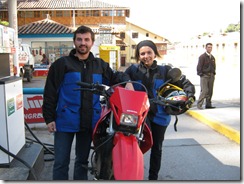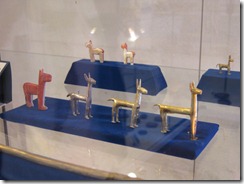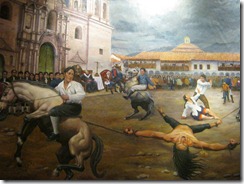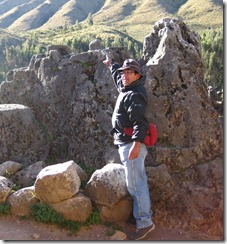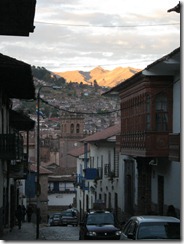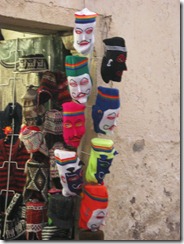Big party last night….oooo, my head. We finally met up with Laura & Anna at the hostel where they were working. And, of course, too much to drink. Carolina seemed to do quite well at beer-pong, but I wasn’t up for that. I’ve had some BAD experiences with drinking games :)
To illustrate how much I like (love or might be addicted to) Coca leaves/tea: Got to bed at 3am. Up at 7pm. First stop on our tour (yes another organised tour) a little market selling touristy type stuff. I was dead by this stage, so got some herbal tea which included Coca leaves. 15min later I was like the Energizer bunny. “Look there. See the Llama? Great view, but wonder what that is. Do you see it? Do you? Do you?” Carolina was a bit shocked :) Did I mention that I love Coca tea?
On this tour we would go to three sites. Pisac, Ollantaytambo and Chinchero. First two have Inca ruins, last one a church. This is where Carolina and I, yes she shared my interest, started to piece together the Inca history & culture for ourselves. Ollantaytambo was more impressive/interesting since it was easy to see how the place was split up into its various purposes. We were able to walk up the “spiritual” side and overlook the grain storage, terraces (used in this case for herbs & flowers), fields for food production and the rock quarry. Pisac was just a nice intro to the Inca city with the terraces (used in this case for all kinds of food) just below. The royal would live inside the city walls.
The Inca were so successful at agriculture that modified potatoes to a few varieties to 1800 types! They were able to grow crops that would only grow at sea level (this is over 2500m high). Wish we could learn from this culture, but they had no written language. You would’ve heard of the Inca empire sometime in your life, but bear in mind that they did not have steel (as in iron), but only Copper (a very soft metal) and did not have the wheel! So no carts or carriages. In fact no horses, only camelids like Llama, Alpaca, etc.
At Ollantaytambo, there is a huge rectangular rock that looks out of place. This was an experiment by a professor to see if it were possible to move these huge stones. They cut out the rock from the quarry and moved it with the help of locals. Not big strong men, but rather normal men, women (some with children on their backs) and a couple of children. And not a couple of thousands. Less than 300 people! Apparently got to do with the slope. Our guide, Paul, was quite knowledgeable which was really cool.
On the way to Chinchero, I started to talk to Paul about hikes to Machu Picchu. By this time I was getting tired of organised tours, so wanted to hike alone to Machu Picchu, specifically Salkantay. We had heard from another person that this hike had been closed to the public due to safety concerns, so you HAD to take an organised tour. Fortunately he was up to make money out of us and told us that this is BS. “Do it yourself.” Great! This was just the lift I needed, because I couldn’t fathom why we couldn’t do it alone. I was amped!
Chinchero is a town know for its woven textiles. Carolina studied textile design and now has a interior decorating shop in the south of Chile. She was VERY interested in the textiles, but we were on a schedule. We arrived after dark, so a quick walk through to the church we saw many people selling on the path, much like Africa.
The church is quite small, but known for its paintings inside. Unfortunately no photos :( Got some pics from the outside to give you an idea. Typical stuff, with the exception that all the paintings were done by Peruvians! They were trained and then commissioned to decorate the church. Lots of subtle Peruvian influence. If you had a keen eye, you would spot one or two things that were out of the ordinary.
Got back REALLY late. The next tour to do was the “City tour.” This is the four ruins close to Cusco. Since we were on good terms with Paul, he recommended (since it was more our style) that we do this on our own. The organised tour is very rushed. With all the “info” places in Cusco, he was the first person to give us proper advice!

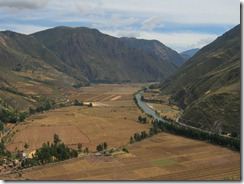

Tourists taking pictures. Very typical way for the locals to make money – View of the Sacred Valley – Cool water gulley at the Pisac Market


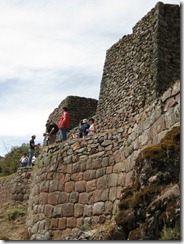

Pisac: Terraces – Tombs – More of Pisac – and me :)

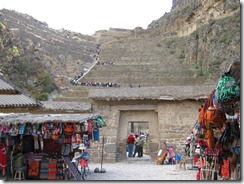

Ollantaytambo: View of the mountains – Looking up at the ruins – Storage on the opposite slope



Ollantaytambo: The royal accommodation – Block that was moved as an experiment – View from the top


Chinchero: People selling goods – Entrance to the church









